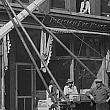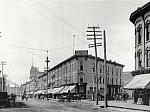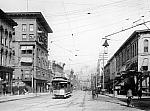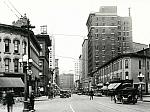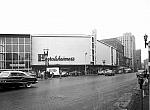
A Better Lighting System in 1912
Care of Tungsten Street Lamps
by Fred Masterson
Masterson’s paper was devoted to a study of the installation of tungsten lamps for street illumination in Grand Rapids, a system preceding the 1912 installation, which follows. He described the installation briefly and said that considerable trouble was experienced at first in renewing burned-out lamps, as it was necessary to draw the arches to one side of the street so that the lamps could be reached from a ladder placed against the building. This system required four men and also did considerable damage to lamps that did not need attention and also to the wiring.
This original method was superseded by a tower wagon, similar to the ones used by traction companies for repairing trolley wires, and a considerable saving has been the result.
On June 8, 1909, the first installation of 270 lamps had been in operation one year. During this time the lamps burned 1,920 hours and consumed 41,000 kilowatt-hours of energy. The number of lamps renewed was 196, which cost the company $225; this makes the cost of renewals for lamps only $0.0055 per kilowatt-hour. The labor necessary to care for 270 lamps is $50, which makes the total cost of renewals $0.0067 per kilowatt-hour.
The one drawback of the series tungsten lamp, operating from a constant potential circuit, is the extinguishing of all the lamps in the arch when one lamp burns out. However, this is not very serious, if the lamps are inspected every morning.
The Boulevard Lighting System
The boulevard lighting system will be turned on in Grand Rapids this week and the arch lights will be turned off. This will be a passing from a small town style to a style that is becoming to a city of this city’s character and pretensions. When the arch lights were first installed, five or six years ago, they represented a new idea in street lighting and it was but natural that they should be admired by the city people and that visitors in town should admire them. The arch system, however, was cheap—just a wire across the street and the lights dangling from them, and the cheapness proved its downfall. The small towns put in arches, and then Grand Rapids began to get weary of its perpetual carnival of fun illuminations and strangers made fun of us as being in the country class. Now Grand Rapids moves on to something better, to a lighting system which the larger cities have adopted and which has the merit of dignity, character, beauty and efficiency. With the new boulevard lights the tendency will be to improve in other directions, to make stores more attractive and the general appearances in keeping. The change will be for the better and it is certain to have a good effect, not merely on the business streets directly affected but on the city as a whole.
The old arch lights have long been an object of ridicule as an appurtenance of a small town, but they have, nevertheless, served a good purpose. These lights were installed by the business men uniting to pay the cost of installation and maintenance. They represent practically the first co-operative effort of the business men in Grand Rapids in all lines of trade. But for their co-operation in putting up the arch lights the present movement resulting in the boulevard lights would have been impossible. The boulevard lights cost about $19,000 for the ornamental posts, globes and installation and it was easier to raise this amount than five years ago it was to raise what the cheap arch lights cost. The ability of the merchants to work together is one of the best signs of progress and it is one of the surest promises of future advancement. We may laugh at the arch lights, now that they are going, but they can be kindly remembered as the starting point of a better spirit among the business men.
Michigan Tradesman, October 9, 1912
Thank you to Jim Winslow for discovering and sharing the Masterson article, "Care of Tungsten Street Lamps."

 facebook
facebook